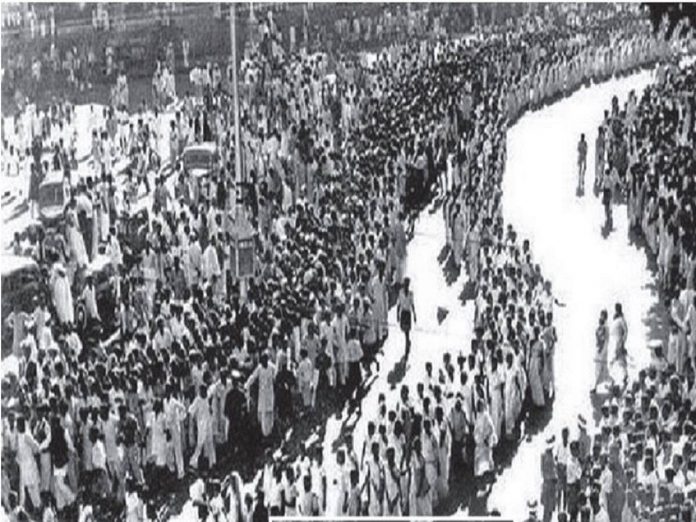Hey dear readers, today that is 8 August , 2021 is the 79th anniversary of the August Kranti Din or Quit India Movement, which is considered as one of the important milestones in the history of the freedom struggle of our country.
The turning point in India’s struggles for freedom from the British Raj was the Quit India Movement which is also known as India August Movement or Bharat Chhodo Andolan . The movement saw people across India come together under the leadership of Mahatma Gandhi to uproot the Britishers. Read the complete blog to know more about this movement and why it was a turning point for our country.
How did it start?
As per British Open University’s archive, by the middle of 1942, Japanese troops were approaching the borders of India and world powers were increasing pressure on the British to solve the issue of India’s future before the end of World War II.
Thus, in March 1942, the British dispatched a committee led by Stafford Cripps, a member of the War Cabinet, to India to discuss the British Government’s Draft Declaration. The draft granted India Dominion status after the war but otherwise conceded few changes to the status quo.
Another part of this was that the British Governor-General of India at the time, Lord Linlithgow, wanted to send Indian soldiers to fight for the UK in the war. The Cripps Mission was a way for the British to negotiate that much needed support from the Indian leaders. However, the conditions of self-rule underlined in the draft declaration were unacceptable to the Congress Working Committee as it did not give immediate and total self-rule. Subsequently, Mahatma Gandhi called for the Quit India Movement.
The Quit India movement was thus the direct result of Britain’s mounting difficulties in World War II and the failure of the Cripps mission to convince Indian leadership at the time to agree for a partial self-rule under which India would still remain a British dominion.
The Quit India movement
The Quit India movement was different from the other two movements associated with Gandhian leadership of the Congress. Gandhi believed in ahimsa but preferred violence to cowardice. Gandhi could not have been unaware of the consequences of his slogans and programme for domestic order and he declared that the British should quit India immediately even if it led to anarchy
The Quit India Movement was a movement launched at the Bombay session of the All India Congress Committee by Mahatma Gandhi on 8 August 1942, during World War II, demanding an end to British rule in India. He decided to launch a mass civil disobedience movement ‘Do or Die’ call to force the British to leave India. The movement was followed, nonetheless, by large-scale violence directed at railway stations, telegraph offices, government buildings, and other emblems and institutions of colonial rule. There were widespread acts of sabotage, and the government held Gandhi responsible for these acts of violence, suggesting that they were a deliberate act of Congress policy. The All India Congress Committee launched a mass protest demanding what Gandhi called “An Orderly British Withdrawal” from India. Even though it was at war, the British were prepared to act. Almost the entire leadership of the Indian National Congress was imprisoned without trial within hours of Gandhi’s speech. All the prominent leaders were arrested, the Congress was banned and the police and army were brought out to suppress the movement. Most spent the rest of the war in prison and out of contact with the masses. Meanwhile, Netaji Subhash Chandra Bose, who stealthily ran away from the British detention in Calcutta, reached foreign lands and organized the Indian National Army (INA) to overthrow the British from India.
The scale of the mass movement, at least in eastern Uttar Pradesh and Bihar, was unusual. Even in other parts of the country the movement was marked by acts of violence, strikes, student protests and disruption of civic life. Militant students of Benares University and even schools played a significant role in this movement. Socialists like Jayaprakash Narayan played an important role in the Quit India movement in eastern UP and Bihar. The British government survived the Quit India movement because it had vast resources to suppress the movement. Although in the villages of eastern UP and Bihar, the British power seemed to be on its last legs, in 1942; this was an erroneous assessment.
The arrest of Gandhi and the Congress leaders led to mass demonstrations throughout India. Thousands were killed and injured in the wake of the ‘Quit India’ movement. Strikes were called in many places. The British swiftly suppressed many of these demonstrations by mass detentions; more than 100,000 people were imprisoned.
The ‘Quit India’ movement, more than anything, united the Indian people against British rule. Although most demonstrations had been suppressed by 1944, upon his release in 1944 Gandhi continued his resistance and went on a 21-day fast. By the end of the Second World War, Britain’s place in the world had changed dramatically and the demand for independence could no longer be ignored.
Highlights
Organizer:
Mohandas Karamchand Gandhi
People involved:
Maulana Abul Kalam Azad, Subhas Chandra Bose, Mohandas Karamchand Gandhi, Mohammed Ali Jinnah, Asoka Mehta, Jaya Prakas Narayan, Jawaharlal Nehru, Sardar Vallabhbhai Patel, Dr Rajendra Prasad, Chakravarti Rajgopalachari.
Published works:
Gandhi, Mahatma, Quit India, ed. by R. K. Prabhu and U. R. Rao (Bombay: Padma Publications, 1942)
We hope that this blog gave you a detailed insight about the quit India movement. Stay tuned with us to know more about such important days and we will make sure to keep you updated.
See you soon!!




